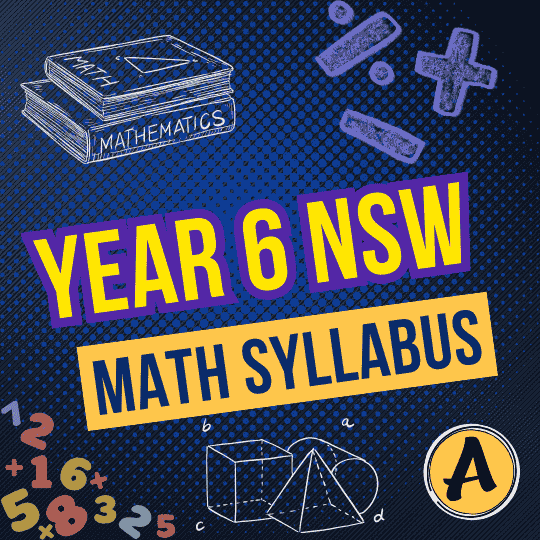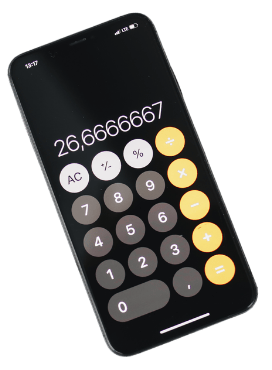Year 6 Maths NSW Curriculum Topics
(Year 6 Curriculum coverage may change from school to school)
Term 1
- Addition, subtraction, multiplication, and division of fractions
- Converting between fractions and decimals
Term 2
- Operations with decimals
- Introduction to percentages (including finding a percentage of an amount)
- Financial mathematics (profit, loss, simple budgeting scenarios)
Term 3
- Geometry of 2D and 3D shapes: angle properties
- Classifying triangles and quadrilaterals
- Exploring circle features
- Calculating area, surface area, and volume for various shapes
Term 4
- Introduction to the Cartesian plane (plotting points in four quadrants)
- Negative numbers in context and computations
- Data analysis (mean, median, mode)
- Probability of events (using fractions, probability terminology)
Introduction to Year 6 NSW Curriculum for Math
The Year 6 Maths NSW curriculum is important as it bridges the gap between primary school mathematics and the more advanced concepts of secondary education. Students strengthen their existing math skills while developing skills for problem-solving, logical reasoning, and real-life math applications
A key focus of Year 6 is core computation skills. Students consolidate their understanding of the four fundamental operations — addition, subtraction, multiplication, and division — and extend this knowledge to work confidently with fractions, decimals, and percentages.
In Geometry, measurement, students learn to classify and analyse 2D and 3D shapes, apply measurement techniques, and explore the properties of angles and circles. In data handling, they develop data interpretation skills through reading and creating graphs and charts, which strengthens their ability to analyse information and make informed decisions.
Importantly, Year 6 mathematics is not just about numbers — it’s about building confidence, resilience, and a positive attitude towards problem-solving. With the right guidance and parental support, students can approach this transition year with curiosity and readiness, setting the stage for success in secondary school.
Term 1, Year 6: Mastering Fractions
In Year 6 Term 1, students focus on mastering fractions, one of the most important foundations in mathematics. They develop skills in addition, subtraction, multiplication, and division of fractions — essential for both classroom success and future maths learning. Working with fractions also deepens their understanding of numbers and how they relate to one another.
Parents can support learning at home through visual aids such as pie charts or fraction strips. Everyday examples, like pizza slices or cake pieces, make adding and subtracting fractions with common denominators easier to grasp. Multiplication and division of fractions can be taught using real-life contexts such as scaling recipes or dividing food portions.
Students also learn to convert between fractions and decimals, a skill that strengthens fluency. For instance, converting ¼ to 0.25 can be practiced through daily problem-solving tasks. Building this solid foundation boosts confidence and prepares students for more advanced concepts.
Term 2, Year 6: Exploring Decimals and Percentages
In Term 2, the focus shifts to decimals and percentages, key topics that connect maths to real-world applications. Students practice decimal operations — addition, subtraction, multiplication, and division — while learning how these concepts appear in daily life.
For example, shopping provides opportunities to add and subtract decimals, while calculating discounts introduces multiplication and division. These experiences help students link maths to practical skills and develop financial awareness.
Percentages are introduced as fractions out of 100, making it easier to convert between percentages, fractions, and decimals. Activities such as calculating exam scores or savings percentages make the concept meaningful. Students also explore financial maths, including profit, loss, and simple budgeting scenarios. These lessons build both academic strength and practical financial literacy.
Term 3, Year 6: Understanding Geometry
In Term 3, students explore 2D and 3D shapes, examine their properties, and classify them. They study triangles (scalene, isosceles, equilateral) and quadrilaterals (square, rectangle, rhombus, parallelogram, trapezoid) in depth to understand the differences in sides and angles.
Students learn circle properties—radius, diameter, circumference, and area—while calculating area, perimeter, surface area, and volume. By applying formulas to real-world problems, they build spatial awareness, logical reasoning, and problem-solving skills that support higher-level maths and everyday tasks.
Term 4, Year 6: Cartesian Plane, Data & Probability
The final term of Year 6 introduces students to the Cartesian plane. They learn how to plot points in all four quadrants using coordinate pairs, applying both positive and negative numbers. This knowledge creates the foundation for algebra and graphing in high school.
Students also explore data analysis, covering mean, median, and mode. These skills help them interpret and summarise information clearly. Parents can reinforce this learning with simple surveys or class projects that involve graphing results.
Finally, students study probability. They learn key terms such as “certain,” “likely,” and “impossible” while expressing probabilities as fractions. Games with dice, spinners, or cards provide fun, practical ways to apply these concepts.
Common Challenges in Year 6 Math for NSW Students
Some topics in Year 6 can be tricky. Fractions often cause confusion, especially when comparing or operating with them. Decimals can also be challenging, particularly when converting between fractions and decimals. Geometry requires strong spatial awareness, and some students struggle with visualising shapes and calculating areas or volumes.
Identifying these struggles early and offering extra support helps students overcome barriers before they progress to more advanced maths.
Encouraging a Growth Mindset for Year 6 NSW Math Students
A growth mindset helps students approach maths with confidence. Mistakes should be seen as opportunities to learn rather than failures. Parents can encourage resilience by praising effort and persistence, rather than just “being smart.”
Linking maths to real-life activities like cooking, budgeting, or planning family activities shows children that maths is not just academic — it’s practical, useful, and valuable.
Conclusion: The Importance of Year 6 Maths
Year 6 maths is a turning point in a child’s education. From fractions, decimals, and percentages to geometry, data, and probability, this year sets the stage for high school success. Strong maths skills are essential for academics, problem-solving, and everyday life.
Parents who stay actively involved in their child’s learning can build confidence, reduce stress, and foster a lifelong positive attitude towards maths. A strong foundation in Year 6 equips students to face future mathematical challenges with competence and curiosity.










